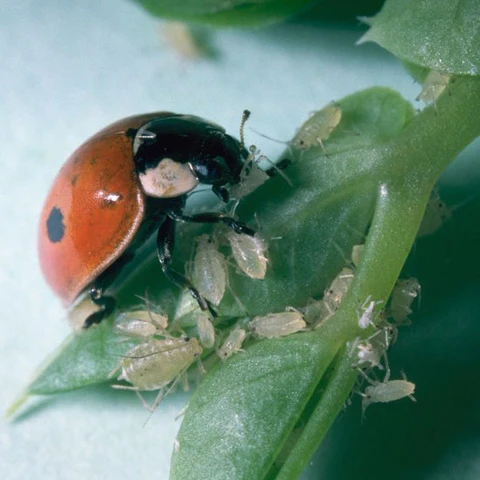
Apid controlling ladybird
What is biological control?
A simple question to ask, but more complicated to answer. There is no single agreed definition of biological control and its interpretation will vary depending on who is asked. The term used can also vary depending on country, cropping system or marketing company with biological control products also referred to as biocontrol, biorational, bioprotection, biologics and biopesticides. There are also other categories of biological inputs available to UK farmers including biological fertilizers and biostimulants.
The IBMA (International Biocontrol Manufacturers Association) defines biocontrol products as tools which originate from nature or are nature-identical when synthesised, generally have a low impact on human health and the environment and are used to manage pests, weeds and diseases.
Biological control should not be confused with organic pest control, biocontrol products are not specific to organic farming. Whilst many biocontrol products can be used in organic production, their use is not limited to organics as they can be used in any cropping system. Biological control is a key component of an Integrated Pest Management (IPM) and sustainable farming system alongside crop selection (incl. resistant plants), cultural techniques, physical barriers, pest/pathogen risk modelling, pest monitoring (incl. pheromone traps linked to action thresholds) and as a last resort selective chemical pesticide use.
Types of biological control products
There are an increasing number and diversity of biocontrol products commercially available. The IBMA categorises biocontrol products into the following:
- Macro-biologicals: Invertebrate Biocontrol Agents (IBCA) which include beneficial nematodes (e.g. Heterorhabditis bacteriophora(; Nematop and Steinernema feltiae; Nemaplus), predatory mites (e.g. Hypoaspis miles) and predatory (e.g. Orius laevigatus) or parasitoid (e.g. Encarsia formosa) insects.
- Micro-biologicals: Microbial Biocontrol Agents (MBCA) which includes bacteria, fungi, viruses and yeasts. For example, the bacteria-based insecticide Bacillus thuringiensis subsp. kurstaki (Delfin) and the CpGv and AoGv baculoviruses used in Madex Top and Capex respectively.
- Semio-chemicals: These include insect pheromones used for mating disruption.
- Natural substances: Substances extracted from, or chemically identical but synthetically manufactured, natural compounds (e.g. garlic extract).

Biocontrols are heavily relied upon in glasshouse grown tomato
History of biocontrol
The use of biological control for the management of pests pre-dates the modern pesticide era, as long as crops have been grown there has been an understanding of using natural predators to manage unwanted pests. More recently the production and use of commercial biological control products has been growing significantly over the past 30 years. The original development of biocontrol industry was driven by growth in demand for organic produce through 1990’s and 2000’s. In more recent years a wider acceptance of biocontrol within agriculture and especially horticulture has developed as a result of various factors:
- Consumer and retailer demand for more sustainable production
- Withdrawal of synthetic chemical pesticide options available to growers, and a slowing rate of introduction of new chemical pesticide active ingredients and products
- Increased resistance to those chemical pesticides remaining
- Better understanding of how to improve the performance of biocontrol products in sustainable IPM systems

Biocontrols are heavily relied upon in tunnel grown strawberries
Within the UK arguably the first true commercial success story of widespread adoption of biocontrol was a beneficial nematode Steinernema feltiae for the control of sciarid fly in mushroom production. The strong performance of the biocontrol product was supported by the humid and warm mushroom growing environment ideally suited to the biocontrol product. Biological control was then also widely adopted within UK greenhouse production with crops such as tomato, pepper and cucumber now heavily reliant on predators, parasitoids and microbial biopesticides. These greenhouse systems are able to contain the biocontrols and have their climate controlled to suit the organism being used. Following this, biocontrol was adopted by semi-protected growing systems such as polytunnels. Biocontrol products such as beneficial nematodes to control black vine weevil, predators to control thrips or mites and microbial pesticides to control diseases are used to control the pest and disease complexes in soft fruit such as strawberry.
Current status of biological control
The global biocontrol market is worth approximately £2billion, with Europe being 30% of the market. Over recent years, the biocontrol market in the UK has been growing at a rate of 15% per year, significantly faster than the typically quoted 2-3% growth in synthetic pesticide market. This rate of growth is expected to continue as new products continue to come to market and farmers become more familiar with biocontrol and how to integrate them into their sustainable farming system and achieve reliable performance.
Regulation of biological control products
Within the UK, biological control products for use in agriculture and horticulture are strictly regulated. Semio-chemicals, micro-biologicals and natural substance are regulated under the same plant protection legislation (EC 1107/2009) as chemical pesticides. Details of products approved for use can be found either on the HSE Pesticide Register Database or the HSE EAMU (formerly SOLA) Database. Macro-biologicals are regulated under the Countryside and Wildlife Act 1981.
Biocontrol products from Andermatt
Andermatt Biocontrol AG is the largest manufacturer of baculoviruses in the world. Within the Andermatt Group there is also expertise in beneficial nematodes, entomopathogenic fungi and beneficial bacteria. More information on the global range of Andermatt technologies can be found by clicking here.

